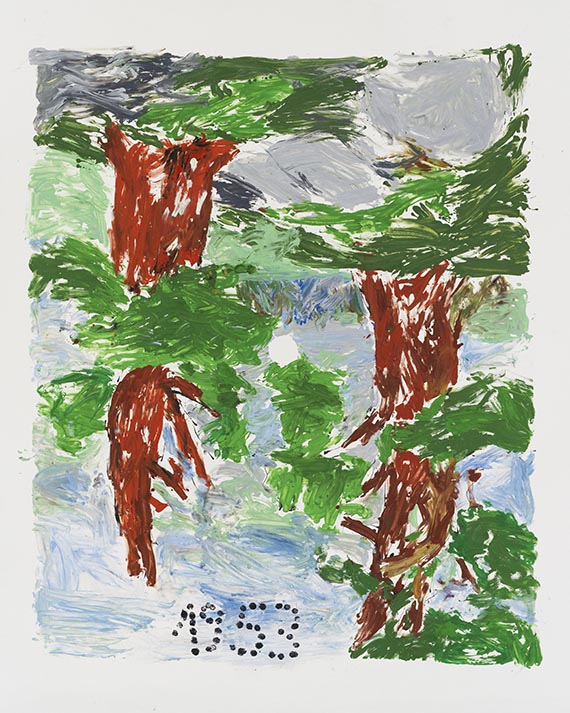Video
8
Georg Baselitz
Apotheke - PiN, 2000.
Oil on canvas
Estimate:
€ 300,000 / $ 348,000 Sold:
€ 406,400 / $ 471,423 (incl. surcharge)
Apotheke - PiN. 2000.
Oil on canvas.
Signed, dated "28.V.2000" and titled on the reverse. 250 x 200 cm (98.4 x 78.7 in). [JS].
• Created in 2000: With this painting, Baselitz established himself as one of the most radical art reformers of the late 20th century.
“Apotheke – PiN“: A reference to two great modernists – Marcel Duchamp (”Pharmacie“, 1914) and Wassily Kandinsky (”Prinzip der inneren Notwendigkeit”, 1912).
• 1953: An allusion to the early painting ‘Zwei Eichen’ (1953/54), which gave direction to Baselitz's work.
• The Forest on Its Head: Inspired by Romantic painting, the forest is the most crucial motif in Baselitz's oeuvre. In 1969, he adopted his characteristic “upside-down” pictorial language for this motif.
• Maximum alienation: an inverted painting, an enigmatic title, a white border, the date marked in the sky, and a large, circular omission at the center of the painting.
• Most recently, the Fondation Beyeler, Basel (2019), the Centre Pompidou, Paris (2021/22), and the White Cube, London (2024), among others, honored Baselitz's work with major retrospective shows.
We are grateful to the Georg Baselitz Archive, Munich, for its kind support in cataloging this lot. The work is documented in the archive.
PROVENANCE: Galerie Thaddeus Ropac, Salzburg.
Private collection, South Germany (acquired from the above in 2001, family-owned ever since).
EXHIBITION: Georg Baselitz. Im Walde von Blainville. Malerei 1996-2000, Essl Collection - Kunst der Gegenwart, Vienna/Klosterneuburg, October 11, 2000 - January 28, 2001, p. 68 (illustrated on p. 69).
LITERATURE: Richard Calvocoressi, Georg Baselitz, London 2021, p. 317 (illustrated).
"Turning the picture upside down proved to me that reality is the image; an object turned upside down is particularly worthy of painting because it is inapt as an object."
Georg Baselitz
“[..] the sock with a hole no longer covers the toe, it peeps into freedom, [..] the plane falls into an air pocket [..], through a hole (again a leak) in the bulb (head), thoughts are allowed to run free, [..] a hole in the picture lets the imagination run wild, like the hole in a record around which the music plays."
Georg Baselitz, Imerpia, August 15, 2000
Oil on canvas.
Signed, dated "28.V.2000" and titled on the reverse. 250 x 200 cm (98.4 x 78.7 in). [JS].
• Created in 2000: With this painting, Baselitz established himself as one of the most radical art reformers of the late 20th century.
“Apotheke – PiN“: A reference to two great modernists – Marcel Duchamp (”Pharmacie“, 1914) and Wassily Kandinsky (”Prinzip der inneren Notwendigkeit”, 1912).
• 1953: An allusion to the early painting ‘Zwei Eichen’ (1953/54), which gave direction to Baselitz's work.
• The Forest on Its Head: Inspired by Romantic painting, the forest is the most crucial motif in Baselitz's oeuvre. In 1969, he adopted his characteristic “upside-down” pictorial language for this motif.
• Maximum alienation: an inverted painting, an enigmatic title, a white border, the date marked in the sky, and a large, circular omission at the center of the painting.
• Most recently, the Fondation Beyeler, Basel (2019), the Centre Pompidou, Paris (2021/22), and the White Cube, London (2024), among others, honored Baselitz's work with major retrospective shows.
We are grateful to the Georg Baselitz Archive, Munich, for its kind support in cataloging this lot. The work is documented in the archive.
PROVENANCE: Galerie Thaddeus Ropac, Salzburg.
Private collection, South Germany (acquired from the above in 2001, family-owned ever since).
EXHIBITION: Georg Baselitz. Im Walde von Blainville. Malerei 1996-2000, Essl Collection - Kunst der Gegenwart, Vienna/Klosterneuburg, October 11, 2000 - January 28, 2001, p. 68 (illustrated on p. 69).
LITERATURE: Richard Calvocoressi, Georg Baselitz, London 2021, p. 317 (illustrated).
"Turning the picture upside down proved to me that reality is the image; an object turned upside down is particularly worthy of painting because it is inapt as an object."
Georg Baselitz
“[..] the sock with a hole no longer covers the toe, it peeps into freedom, [..] the plane falls into an air pocket [..], through a hole (again a leak) in the bulb (head), thoughts are allowed to run free, [..] a hole in the picture lets the imagination run wild, like the hole in a record around which the music plays."
Georg Baselitz, Imerpia, August 15, 2000
Georg Baselitz – Painting to provoke
A blank spot at its center, an omission of ten centimeters in diameter in a monumental depiction of two thick oak trunks turned upside down. Their roots point upward, and the sky is at their feet, bearing the mysteriously large inscription of the year 1953 and the seemingly incongruous title “Apotheke – PiN,” which is disassociated from the actual depiction. All of this confronts the viewer of our powerful painting from 2000 with a thrilling puzzle. In deciphering this piece as the essence of his art, it is crucial to understand that Baselitz had explored the potential of aesthetic provocation in his revolutionary painting since the 1960s. His powerful figurative painting is an unconstrained probing of conventions and norms, a conscious violation of established categories, and a battle against traditional conceptions of art. This outstanding creative work has made Georg Baselitz one of the most prominent representatives of contemporary German art.
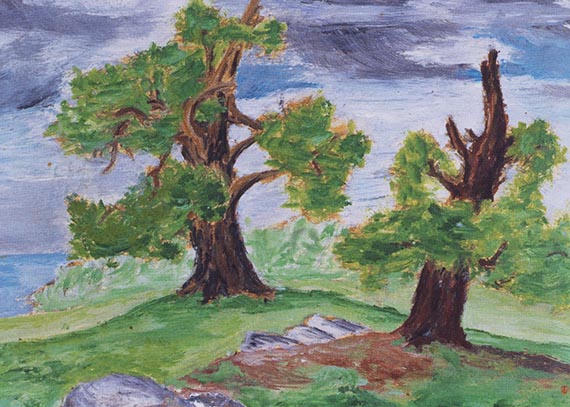
An exhibition at the Berlin gallery Werner & Katz in 1963 brought Baselitz overnight fame: The shocking painting Der nackte Mann (The Naked Man, 1962), which shows a haggard male nude with an oversized penis lying dead in a hole, was one of the works that led to the scandal. The work refers both to traditional depictions of the dead Christ and to images of inmates of Nazi concentration camps, a subject that was largely suppressed in post-war Germany. The following day, the tabloid BZ ran the headline, “It's a scandal the likes of which Berlin hasn't seen since the war.”
In 1969, Baselitz created “Der Wald auf dem Kopf” (The Wood On Its Head, Museum Ludwig, Cologne), the first painting where he turned the motif upside down. Once again, Baselitz radically challenged traditional viewing habits and established conventions of art and reality. This bold step, which quickly became Baselitz's artistic trademark, secured him a permanent place in art history from then on and liberated painting. “The act of painting emancipates itself from representation, from the imitative, and allows the works to appear figurative and abstract at once. (Quoted from: Toni Stoss, in: Georg Baselitz, Paintings and Sculptures 1960-2008, Cologne/Salzburg 2009, p. 8) This painting, too, was inspired by a previous work and thus by art historical tradition, as the motif of “Der Wald auf dem Kopf” is based on the painting “Wermsdorfer Wald” by Ferdinand von Raysky from 1859 (Staatliche Kunstsammlungen Dresden). In his early work “Zwei Eichen” (Two Oaks, 1953/54), created while he was still living in his home country of East Germany, Baselitz had already explored Romantic painting and, in this rather traditional landscape, referred to Carl Gustav Carus' famous work “Eichen am Meer” (Oaks by the Sea, 1834/35, Staatliche Kunstsammlungen Dresden). The large inscription “1953” in our monumental oak painting “Apotheke – PiN” thus refers to Baselitz's early work “Zwei Eichen” (1953/54) with a similar motif.
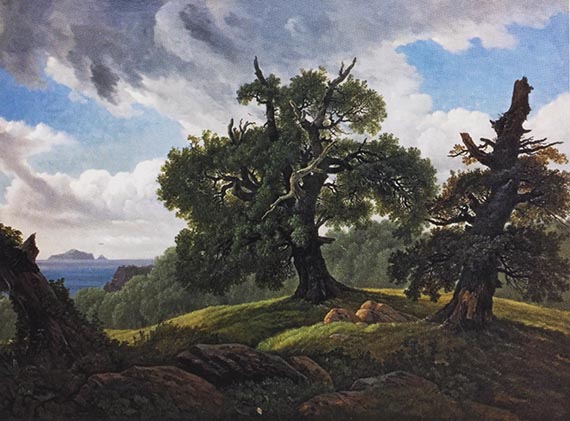
The forest – a part of the German identity and a symbol of a homeland lost
Despite rich sources of inspiration, the forest remains Baselitz's work's central and defining visual theme. Literature and the art of Romanticism played a significant role in making the forest a central part of the German identity. In the catalog for the Baselitz exhibition in London in 2007, Elias Canetti is quoted as saying: “There is no other modern nation in which the spirit of identification with the forest [forest feeling] has remained as vivid” (E. Canetti, quoted in: N. Rosenthal (ed.), Georg Baselitz, exhibition catalog, Royal Academy of Arts, London 2007, p. 121). Baselitz has not only explored German history, questions of identity, and his biography in his work but has always firmly integrated the legacy of art history into his pictorial thoughts. Ferdinand von Rayski's forest scenes and Saxon landscapes, which Baselitz refers to in his famous painting “Der Wald auf dem Kopf,” not only represent a naturalistic pictorial tradition dating back to the 19th century, they are also childhood places for Baselitz and thus the visualization of a sense of home. Baselitz's landscapes are reminiscent of the landscapes of his childhood in East Germany, places that were inaccessible to him for more than 30 years after he had moved to West Berlin just a few years before the Berlin Wall was built. Caspar David Friedrich's blurred soulscapes represent another vital source of inspiration for Baselitz's painting. In an almost visionary formulation for his time, Friedrich said: “A landscape is a state of mind. Man should not just paint what he sees, but also what he sees within himself.” This radical new way of thinking proved to be crucial for Baselitz and his examination of landscapes from his memory, and it is the reason for his innovative, lifelong engagement with this profoundly emotional motif. The “upside-down” memories of his native region of Saxony are fascinating in the way their visual language vibrantly oscillates between Realism and abstraction. In our monumental forest landscape “Apotheke – PiN,” Baselitz enhances them with numerous art-historical references and alienating effects, such as the white, circular omission in the center of the painting, adding a complex theoretical level of reflection.
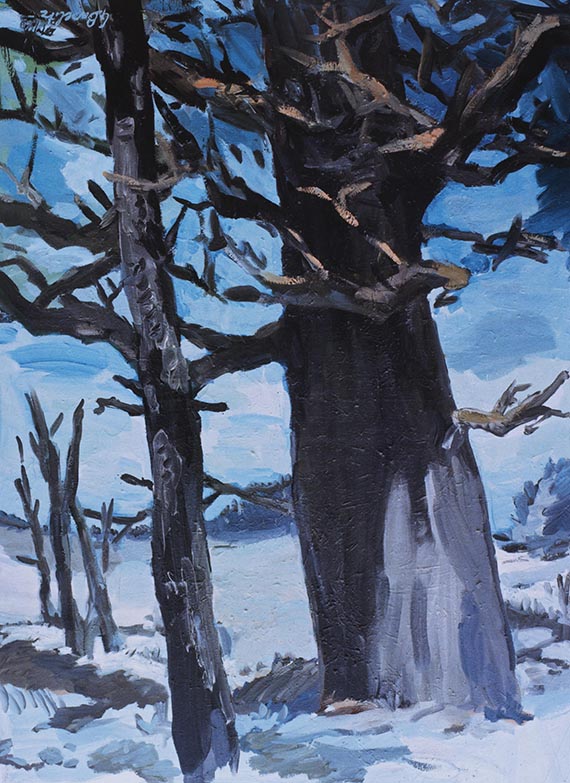
“Upside Down” and beyond – ‘Apotheke – PiN’ and the ultimate emancipation from reality
Thanks to his momentous decision to turn his subjects upside down, Baselitz emancipated the act of painting from the objective world. Rotating the image by 180 degrees, Baselitz invented an artistic trademark that no one has ever dared to copy. Baselitz explains: “The rule for this is artificial, but no more wrong than conventional rules. [...] After all, no painting or piece of paper on a table has a natural direction or an inherent up, down, right, or left. It is only an agreed form, a convention. Moreover, I have discovered that it is possible to paint by contradicting this agreement and turning the motifs around” (quoted from: Jens Hinrichsen, Der Disharmoniker. Baselitz wird 85, in: Monopol, January 21, 2023).
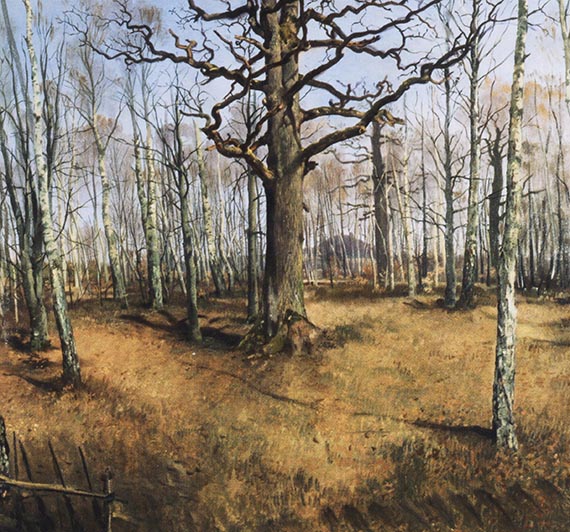
In our monumental depiction of two oaks, Baselitz takes artistic alienation effects to new extremes by adding a wide, unpainted margin and a circular omission in the center of the painting, which, like a peephole, reveals the unpainted canvas. Creating a pure painting emancipated from the constraints of illusionistic representation that have existed since the Renaissance, Baselitz takes the liberation of the act of painting to new heights. The confusing and seemingly unsuitable title “Apotheke – PiN” is Baselitz's nod to Marcel Duchamp's second Readymade “Pharmacie (Apotheke)” from 1914: a reproduction of a drawing of a landscape with trees, a cheap, mass-produced item that Duchamp elevated to the status of a work of art by adding just two small dabs of color in gouache. “Pharmacie (Apotheke)” is considered a key work in the oeuvre of the avant-gardist Marcel Duchamp, the revolutionary modernizer of the traditional concept of art. The title supplement “PiN” points to another significant innovative force in the history of modern art: Wassily Kandinsky and the “principle of inner necessity” formulated in his famous art theory essay 'On the Spiritual in Art' (Munich 1912). According to Kandinsky's theory, a work of art should not depict external reality but reflect the artist's inner world through form and color as directly as possible. Baselitz's “Apotheke – PiN” thus combines all the elements that make Baselitz's painting so unique. This monumental forest landscape, executed in a powerful, liberated style and packed with diverse art historical references, is both unsettling and captivating. It is the painted essence of Baselitz's epochal artistic output and amounts to a fascinating manifesto. [JS]
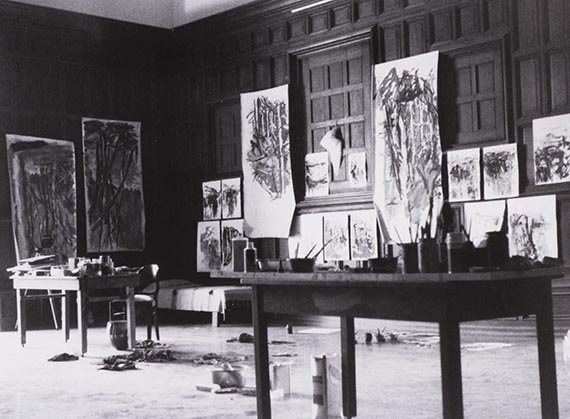
A blank spot at its center, an omission of ten centimeters in diameter in a monumental depiction of two thick oak trunks turned upside down. Their roots point upward, and the sky is at their feet, bearing the mysteriously large inscription of the year 1953 and the seemingly incongruous title “Apotheke – PiN,” which is disassociated from the actual depiction. All of this confronts the viewer of our powerful painting from 2000 with a thrilling puzzle. In deciphering this piece as the essence of his art, it is crucial to understand that Baselitz had explored the potential of aesthetic provocation in his revolutionary painting since the 1960s. His powerful figurative painting is an unconstrained probing of conventions and norms, a conscious violation of established categories, and a battle against traditional conceptions of art. This outstanding creative work has made Georg Baselitz one of the most prominent representatives of contemporary German art.

Georg Baselitz, Zwei Eichen, 1953/54, oil on cardboard. © Georg Baselitz 2025
An exhibition at the Berlin gallery Werner & Katz in 1963 brought Baselitz overnight fame: The shocking painting Der nackte Mann (The Naked Man, 1962), which shows a haggard male nude with an oversized penis lying dead in a hole, was one of the works that led to the scandal. The work refers both to traditional depictions of the dead Christ and to images of inmates of Nazi concentration camps, a subject that was largely suppressed in post-war Germany. The following day, the tabloid BZ ran the headline, “It's a scandal the likes of which Berlin hasn't seen since the war.”
In 1969, Baselitz created “Der Wald auf dem Kopf” (The Wood On Its Head, Museum Ludwig, Cologne), the first painting where he turned the motif upside down. Once again, Baselitz radically challenged traditional viewing habits and established conventions of art and reality. This bold step, which quickly became Baselitz's artistic trademark, secured him a permanent place in art history from then on and liberated painting. “The act of painting emancipates itself from representation, from the imitative, and allows the works to appear figurative and abstract at once. (Quoted from: Toni Stoss, in: Georg Baselitz, Paintings and Sculptures 1960-2008, Cologne/Salzburg 2009, p. 8) This painting, too, was inspired by a previous work and thus by art historical tradition, as the motif of “Der Wald auf dem Kopf” is based on the painting “Wermsdorfer Wald” by Ferdinand von Raysky from 1859 (Staatliche Kunstsammlungen Dresden). In his early work “Zwei Eichen” (Two Oaks, 1953/54), created while he was still living in his home country of East Germany, Baselitz had already explored Romantic painting and, in this rather traditional landscape, referred to Carl Gustav Carus' famous work “Eichen am Meer” (Oaks by the Sea, 1834/35, Staatliche Kunstsammlungen Dresden). The large inscription “1953” in our monumental oak painting “Apotheke – PiN” thus refers to Baselitz's early work “Zwei Eichen” (1953/54) with a similar motif.

Carl Gustav Carus, Eichen am Meer, 1834/35, oil on canvas, Staatliche Kunstsammlungen Dresden.
The forest – a part of the German identity and a symbol of a homeland lost
Despite rich sources of inspiration, the forest remains Baselitz's work's central and defining visual theme. Literature and the art of Romanticism played a significant role in making the forest a central part of the German identity. In the catalog for the Baselitz exhibition in London in 2007, Elias Canetti is quoted as saying: “There is no other modern nation in which the spirit of identification with the forest [forest feeling] has remained as vivid” (E. Canetti, quoted in: N. Rosenthal (ed.), Georg Baselitz, exhibition catalog, Royal Academy of Arts, London 2007, p. 121). Baselitz has not only explored German history, questions of identity, and his biography in his work but has always firmly integrated the legacy of art history into his pictorial thoughts. Ferdinand von Rayski's forest scenes and Saxon landscapes, which Baselitz refers to in his famous painting “Der Wald auf dem Kopf,” not only represent a naturalistic pictorial tradition dating back to the 19th century, they are also childhood places for Baselitz and thus the visualization of a sense of home. Baselitz's landscapes are reminiscent of the landscapes of his childhood in East Germany, places that were inaccessible to him for more than 30 years after he had moved to West Berlin just a few years before the Berlin Wall was built. Caspar David Friedrich's blurred soulscapes represent another vital source of inspiration for Baselitz's painting. In an almost visionary formulation for his time, Friedrich said: “A landscape is a state of mind. Man should not just paint what he sees, but also what he sees within himself.” This radical new way of thinking proved to be crucial for Baselitz and his examination of landscapes from his memory, and it is the reason for his innovative, lifelong engagement with this profoundly emotional motif. The “upside-down” memories of his native region of Saxony are fascinating in the way their visual language vibrantly oscillates between Realism and abstraction. In our monumental forest landscape “Apotheke – PiN,” Baselitz enhances them with numerous art-historical references and alienating effects, such as the white, circular omission in the center of the painting, adding a complex theoretical level of reflection.

Georg Baselitz, Der Wald auf dem Kopf, 1969, oil on canvas, Museum Ludwig, Cologne. © Georg Baselitz 2025
“Upside Down” and beyond – ‘Apotheke – PiN’ and the ultimate emancipation from reality
Thanks to his momentous decision to turn his subjects upside down, Baselitz emancipated the act of painting from the objective world. Rotating the image by 180 degrees, Baselitz invented an artistic trademark that no one has ever dared to copy. Baselitz explains: “The rule for this is artificial, but no more wrong than conventional rules. [...] After all, no painting or piece of paper on a table has a natural direction or an inherent up, down, right, or left. It is only an agreed form, a convention. Moreover, I have discovered that it is possible to paint by contradicting this agreement and turning the motifs around” (quoted from: Jens Hinrichsen, Der Disharmoniker. Baselitz wird 85, in: Monopol, January 21, 2023).

Ferdinand von Raysik, Wermsdorf Forest, around 1859, oil on canvas, Staatliche Kunstsammlungen Dresden.
In our monumental depiction of two oaks, Baselitz takes artistic alienation effects to new extremes by adding a wide, unpainted margin and a circular omission in the center of the painting, which, like a peephole, reveals the unpainted canvas. Creating a pure painting emancipated from the constraints of illusionistic representation that have existed since the Renaissance, Baselitz takes the liberation of the act of painting to new heights. The confusing and seemingly unsuitable title “Apotheke – PiN” is Baselitz's nod to Marcel Duchamp's second Readymade “Pharmacie (Apotheke)” from 1914: a reproduction of a drawing of a landscape with trees, a cheap, mass-produced item that Duchamp elevated to the status of a work of art by adding just two small dabs of color in gouache. “Pharmacie (Apotheke)” is considered a key work in the oeuvre of the avant-gardist Marcel Duchamp, the revolutionary modernizer of the traditional concept of art. The title supplement “PiN” points to another significant innovative force in the history of modern art: Wassily Kandinsky and the “principle of inner necessity” formulated in his famous art theory essay 'On the Spiritual in Art' (Munich 1912). According to Kandinsky's theory, a work of art should not depict external reality but reflect the artist's inner world through form and color as directly as possible. Baselitz's “Apotheke – PiN” thus combines all the elements that make Baselitz's painting so unique. This monumental forest landscape, executed in a powerful, liberated style and packed with diverse art historical references, is both unsettling and captivating. It is the painted essence of Baselitz's epochal artistic output and amounts to a fascinating manifesto. [JS]

Baselitz's studio at Schloss Derneburg, around 1975. © Georg Baselitz 2025
8
Georg Baselitz
Apotheke - PiN, 2000.
Oil on canvas
Estimate:
€ 300,000 / $ 348,000 Sold:
€ 406,400 / $ 471,423 (incl. surcharge)
Headquarters
Joseph-Wild-Str. 18
81829 Munich
Phone: +49 89 55 244-0
Fax: +49 89 55 244-177
info@kettererkunst.de
Louisa von Saucken / Undine Schleifer
Holstenwall 5
20355 Hamburg
Phone: +49 40 37 49 61-0
Fax: +49 40 37 49 61-66
infohamburg@kettererkunst.de
Dr. Simone Wiechers / Nane Schlage
Fasanenstr. 70
10719 Berlin
Phone: +49 30 88 67 53-63
Fax: +49 30 88 67 56-43
infoberlin@kettererkunst.de
Cordula Lichtenberg
Gertrudenstraße 24-28
50667 Cologne
Phone: +49 221 510 908-15
infokoeln@kettererkunst.de
Hessen
Rhineland-Palatinate
Miriam Heß
Phone: +49 62 21 58 80-038
Fax: +49 62 21 58 80-595
infoheidelberg@kettererkunst.de
We will inform you in time.




 Lot 8
Lot 8 